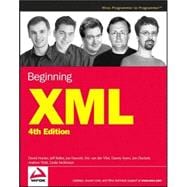
Jeff Rafter is an independent consultant based in Redlands, California. His focus is one emerging technology and web standards, including XML and validation. he currently works with Baobab Health Partnership with a focus on improving world health.
Joe Fawcett (http://joe.fawcett.name) started programming in the 1970s and worked briefly in IT when leaving full-time education. he then pursued a more checkered career before returning to software development in 1994. In 2003 he was awarded the title of Microsoft Most Valuable Professional in XML for community contributions and technical expertise; he has subsequently been re-awarded every year since. Joe currently works in London and is head of software development for FTC Kaplan Ltd., a leading international provider of accountancy and business training.
Eric van der Vlist is an independent consultant and trainer. His domains of expertise include web development and XML technologies. He is the creator and main editor of XMLfr.org, the main site dedicated to XML technologies in French, the lead author of Professional Web 2.0 Programming, the author of the O'Reilly animal books XML Schema and RELAX NG and a member or the ISO DSDL (http://dsdl.org) working group focused on XML schema languages. he is based in Paris and can be reached at vdv@dyomedea.com , or meet him at one of the many conferences where he presents his projects.
Danny Ayers is a freelance developer and consultant specializing in cutting-edge web technologies. His blog (http://dannyayers.com) tends to feature material relating to the Semantic Web and/or cat photos.
Jon Duckett co-authored Wrox Press' first book on XML in 1998. After 4 years with Wrox in the UK, Jon is now a freelance web developer working with clients in the UK, US and Australia, and has co-authored 10 programming books.
Andrew Watt has been programming for 20 years, including 10 years work with the Web. He has several books in the areas of XML and XSLT to his credit and is well known for his work on XML.com.
Linda McKinnon has more than 10 years of experience as a successful trainer and network engineer, assisting both private and public enterprises in network architecture design, implementation, system administration, and RP procurement. She is a renowned mentor and has published numerous Linux study guide for Wiley Press and Gearhead Press.
| Acknowledgments | |
| Introduction | |
| Introduction | |
| What Is XML? | |
| Well-Formed XML | |
| XML Namespaces | |
| Validation | |
| Document Type Definitions | |
| XML Schemas | |
| RELAX NG | |
| Processing | |
| XPath | |
| XSLT | |
| Databases | |
| XQuery, the XML Query Language | |
| XML and Databases | |
| Programming | |
| The XML Document Object Model (DOM) | |
| Simple API for XML (SAX) | |
| Communication | |
| RSS, Atom, and Content Syndication | |
| Web Services | |
| SOAP and WSDL | |
| Ajax | |
| Display | |
| Cascading Style Sheets (CSS) | |
| XHTML | |
| Scalable Vector Graphics (SVG) | |
| XForms | |
| Case Study | |
| Case Study: Payment Calculator | |
| Case Study: Payment Calculator-Ruby on Rails | |
| Exercise Solutions | |
| XPath Reference | |
| XSLT Reference | |
| The XML Document Object Model | |
| XML Schema Element and Attribute Reference | |
| XML Schema Data Types Reference | |
| SAX 2.0.2 | |
| Reference | |
| Index | |
| Table of Contents provided by Publisher. All Rights Reserved. |
The New copy of this book will include any supplemental materials advertised. Please check the title of the book to determine if it should include any access cards, study guides, lab manuals, CDs, etc.
The Used, Rental and eBook copies of this book are not guaranteed to include any supplemental materials. Typically, only the book itself is included. This is true even if the title states it includes any access cards, study guides, lab manuals, CDs, etc.